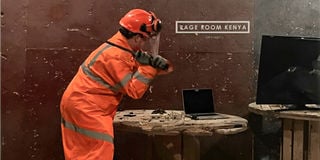
Revelers at the rage room donned in protective gear at their act.
The sound of shattering glass pierces the air, followed by the satisfying crunch of a TV screen imploding under the weight of a sledgehammer. A shrill scream echoes off the walls, barely audible over the angry music serenading the precinct.
This is not a crime scene or the aftermath of a home invasion - it is just another day at Nairobi's first and only rage room.
Tucked away in an unassuming building along Ngong Road, the Rage Room Kenya offers a unique form of stress relief to the city's frazzled residents. For 45 minutes and Sh3,500 for a single person, Sh6,000 for two people, and Sh15,000 for seven people, people wear protective gear and unleash their pent-up frustrations on an array of inanimate objects.
It is equal parts therapeutic session and demolition derby, with a soundtrack of your choosing.
“I felt really relieved,” says Tracy Kamweti, a marketing executive who first discovered the rage room in 2021.
“There are not so many places in Nairobi where you can just go and scream— just let loose.”
The concept of rage rooms originated in Japan in the mid-2000s, quickly spreading to other parts of Asia and eventually the West. Kenya’s version, founded by software engineer Rodney Mutembei, opened its doors in 2021 amidst the height of the Covid-19 pandemic.
“The idea actually came to me before Covid-19, oddly enough,” Mr Mutembei says. “I had seen something similar in Eastern Asia, particularly Japan, where they essentially pioneered the concept of rage rooms—places where people come in and smash things.”
For Mr Mutembei, the rage room was more than just a business opportunity - it was a response to a growing need he saw in his generation. “Our generation, this is something we go through a lot,” he says. “I'm a millennial. So, our generation doesn't really have an outlet or a place where to like, release, not only rage, just pressure, you know, just be free, in a sense."
The process of visiting the rage room is carefully choreographed to ensure both safety and catharsis. Upon arrival, patrons must prove they are over 18 and sign a waiver. They are then kitted out in full protective gear - coveralls, goggles, gloves, and boots. A brief safety lecture follows, and then it's time to rage.

Rodney Mutembei, founder, Rage Room Nairobi.
Inside the room, visitors find an assortment of breakable items - old TVs, microwaves, radios, plates, and more. Some are donated by the public, while others are purchased secondhand. Armed with bats, wrenches, and wooden planks, patrons are free to destroy to their heart's content.
For Ms Kamweti, the experience, she says, was transformative. She visited the rage room several times, during a particularly difficult period in her life.
“At that point, I'd lost my job. I had to move back home. Everything was just going wrong during Covid,” she says. “The rage room maiden experience made me feel like, you know, I could still handle myself."
The rage room's appeal is not limited to millennials going through quarter-life crises. Mr Mutembei notes that 60 to 70 percent of their clientele are white-collar professionals.
“People from offices who it's like the daily routine from home, from the office, home. You know, there isn't really a way to release that stress or anger that you're feeling,” he says.
He says a rage room is not just a place to break things, but has a holistic mental health element to it. If a person shows up at their doors three times, they are offered a free session with psychologists. They say it is an acknowledgement that while smashing things can provide temporary relief, it is not a substitute for professional help.
"If we get repeat customers, let's say in a month someone comes for more than three times, we have partnered with a few psychologist friends of ours whereby they'd be eligible to -- they have a grouping of three psychologists, two female, one male, that they can choose," Mr Mutembei says.
Ms Kamweti has been to the rage room more than three times, and she says the psychologist, gave her pointers on other things to use to let go of stress, "let go of my anger, how to meditate, how to journal."
"So it was helpful because you're talking to a therapist, she's trying to see where all this anger, all this built-in anger, and all this pain is coming from," she told Lifestyle.
Hurling crockery and shattering TV screens with bats and crowbars, may seem like an interesting business, but Rage Room Kenya has faced its share of challenges. Regulatory issues with the county government have forced temporary closures, with officials unsure how to classify the business.
"It's being classified as an entertainment area rather than a recreational area. And for us, it's like an NGO [non-governmental organisation]," Ms Mutembei.
However, the bureaucratic hurdles have not dampened enthusiasm for the concept.
Mr Mutembei reports that their rage room has a client base of over 1,500 people and he has plans to expand to other Kenyan cities and eventually the wider region.
For anyone trying a rage room for the first time, Ms Kamweti shares this advice: "Come with an open mind. Imagine the world no longer exists—it's just you, alone in that moment. It’s a surreal and unique experience."

Tracy Kamweti is a marketing executive based in Nairobi.
She emphasizes that the goal isn't destruction for destruction's sake, but rather a physical outlet for emotional release. "The rage room experience is not that because I want to break things. It's a method of releasing the way I'm feeling," she says.
"When you go for therapy, they give you different methods of releasing how you're feeling. There's meditation, there's journaling, there's this one for breaking."
As mental health awareness grows in Kenya, unconventional therapies like rage rooms are gaining acceptance. While smashing a TV screen may not solve deep-seated psychological issues, it can provide a much-needed release valve for the stresses of modern life.
Mr Mutembei reflects on the long-term impact of rage rooms: "They provide a safe space for people to release their rage, anger, and frustration in an environment designed for that purpose. It allows them to let go without the risk of lashing out at home," he says.
However, psychologists have a different view.
Stella Maina, a counselling psychologist based in Nairobi, expresses reservations about the long-term benefits of rage rooms.
"While participants may experience a temporary sense of relief or what some describe as a 'catharsis-like feeling', it's crucial to understand that this is very short-lived," Ms Maina explains. "It's a quick fix, but it doesn't address the root causes of stress or anger."
Ms Maina likens the experience to a bandaid solution: "It's like a couple fighting over an issue. One person might scream and break things, but has the problem been solved? Not really. They still need to sit down and discuss the issue at hand." "It's a form of avoidance. You're not actually dealing with the crisis; you're just momentarily escaping it."
The psychologist notes the importance of guided, professional help in managing stress and anger. "Dealing with emotions needs to be programmed, observed, and even prescribed," she says. "It's similar to treating a medical condition – you wouldn't simply buy pneumonia or tuberculosis medication without a proper diagnosis and dosage instructions from a doctor."
So what alternatives do mental health professionals recommend for stressed-out individuals seeking relief? Ms Maina suggests a range of evidence-based techniques—guided therapy sessions. Working with a professional to process emotions and develop healthy coping strategies. Journalling is not just writing aimlessly, but using structured prompts to process thoughts and feelings. Exercise activities like gym workouts can help balance brain chemistry and reduce stress hormones like cortisol. Mindfulness and meditation, are practices that help individuals stay present and manage their emotional responses.
For those dealing with severe anger issues or trauma, Ms Maina strongly advises against self-prescribed "remedies" like rage rooms. "These individuals need professional guidance to work through their emotions safely and effectively," she says.
The debate surrounding rage rooms highlights a broader conversation about stress management in modern urban environments. As city dwellers face increasing pressures, the search for effective coping mechanisms becomes more crucial.
"We need to be developing healthy, sustainable ways to deal with stress," Ms Maina emphasises. "Quick fixes might feel good at the moment, but they don't equip us with the tools we need for long-term emotional well-being."







